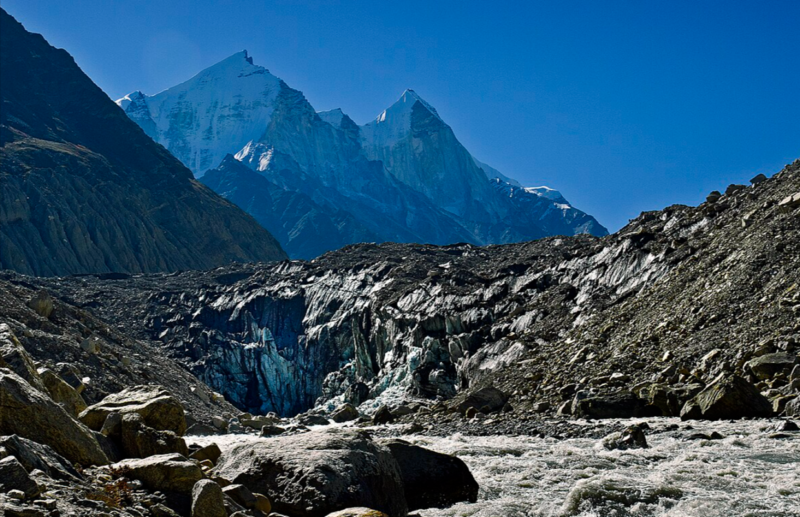Gangotri Glacier: The Sacred Source of the Ganges!
Nestled in the heart of the Indian Himalayas, the Gangotri Glacier stands as a magnificent natural wonder and a sacred site. Located in the Uttarkashi district of Uttarakhand, this massive glacier is the primary source of the Ganges River, one of the most important and holy rivers in India. Spanning around 30 kilometers in length and covering an area of approximately 143 square kilometers, Gangotri Glacier is not only significant in terms of geography but also holds immense cultural, spiritual, and ecological importance.
Geographical Significance
The Gangotri Glacier originates in the Chaukhamba range of the Garhwal Himalayas, at an elevation of around 7,000 meters. It flows northwest before turning southwest and eventually giving rise to the Bhagirathi River at Gomukh, which is the snout of the glacier. The Bhagirathi later merges with the Alaknanda River at Devprayag, where the river officially takes the name Ganga or Ganges.
Surrounded by majestic peaks like Shivling, Thalay Sagar, Meru, and Bhagirathi III, the glacier region is characterized by rugged terrain, moraines, crevasses, and icefalls. The glacier is fed by several tributary glaciers, including Raktavarn, Chaturangi, and Kirti, all of which contribute to its mass and movement.
Spiritual Importance
The Gangotri Glacier holds an esteemed place in Hindu mythology. It is believed that the Ganges River descended from the heavens to the earth to purify the souls of the ancestors of King Bhagirath. To prevent the earth from being destroyed by the river’s mighty force, Lord Shiva caught the river in his locks and released it gently. The place where the river is said to have touched the earth is Gomukh, meaning “Cow’s Mouth”, due to the shape of the glacier’s snout.
Gangotri town, located about 19 kilometers downstream from Gomukh, is a major pilgrimage site. The Gangotri Temple, dedicated to Goddess Ganga, attracts thousands of devotees every year, especially during the summer months when the region is accessible.
Ecological Importance
Gangotri Glacier is not only a cultural and spiritual landmark but also an ecological one. It plays a crucial role in sustaining the northern Indian plains by feeding the Ganges River, which supports agriculture, drinking water supply, and hydroelectric power for millions of people.
The glacier is part of the Gangotri National Park, a protected area covering over 2,390 square kilometers. This high-altitude ecosystem is home to rare and endangered species like the snow leopard, Himalayan blue sheep (bharal), musk deer, and a variety of alpine flora. Conservation efforts in the region aim to protect both the glacier and the unique biodiversity it supports.
Climate Change and Retreat
One of the major concerns surrounding Gangotri Glacier is its rapid retreat due to climate change. Scientific studies have shown that the glacier has been receding at an alarming rate—averaging 15 to 20 meters per year in recent decades. While glacial retreat is a natural process, the accelerated pace seen in recent years is primarily attributed to global warming and reduced snowfall in the region.
The shrinking of the glacier poses serious threats, including reduced water flow to the Ganges, which could impact millions of people downstream. It also increases the risk of glacial lake outburst floods (GLOFs), which can cause catastrophic damage to life and property in the valleys below.
Trekking and Tourism
The Gangotri Glacier trek is one of the most popular high-altitude treks in India, attracting adventure seekers, pilgrims, and nature lovers alike. The trek usually starts from Gangotri town and goes up to Gomukh (13,200 ft), covering about 18–19 kilometers one way. For those seeking more adventure, the route can be extended to Tapovan, Nandanvan, or even further to Kedartal and Vasuki Tal.
Trekkers are treated to breathtaking views of snow-clad peaks, pristine rivers, and rare Himalayan flora and fauna. However, due to the fragile ecosystem, the Indian government and forest department regulate trekking activities, issuing limited permits and encouraging eco-friendly practices.
Scientific Research and Monitoring
Recognizing the glacier’s critical importance, several research institutions, including the Wadia Institute of Himalayan Geology, have been monitoring Gangotri Glacier. These studies focus on glacial mass balance, movement, melting rates, and climatic patterns.
Remote sensing, satellite imagery, and field studies have helped scientists better understand the dynamics of the glacier and predict its future behavior. The data collected plays a crucial role in formulating climate policy, disaster management plans, and sustainable development models for the Himalayan region.
Challenges and Conservation
Despite the efforts to monitor and conserve the glacier, there are numerous challenges. Increasing tourism, unregulated construction, deforestation, and lack of awareness among visitors contribute to environmental degradation. Waste left behind by trekkers and pilgrims pollutes the pristine environment and threatens local wildlife.
The government, NGOs, and local communities have initiated various campaigns to promote responsible tourism. These include “Clean Ganga” campaigns, bans on plastic usage, and the establishment of eco-sensitive zones. Raising awareness about the glacier’s importance and the threats it faces is key to ensuring its preservation for future generations.
Conclusion
The Gangotri Glacier is more than just a source of a river; it is a symbol of India’s natural beauty, spiritual heritage, and ecological interdependence. As climate change looms large and glaciers around the world shrink, the need to protect and preserve Gangotri has never been more urgent.
Whether viewed through the lens of faith, science, or adventure, Gangotri Glacier remains a place of awe and reverence. It reminds us of the delicate balance between nature and civilization and the collective responsibility we share in safeguarding our planet’s most vital resources.




